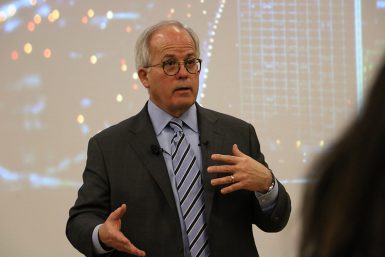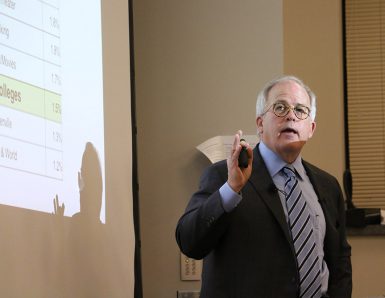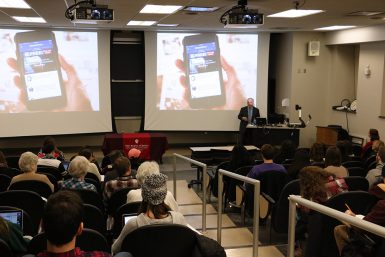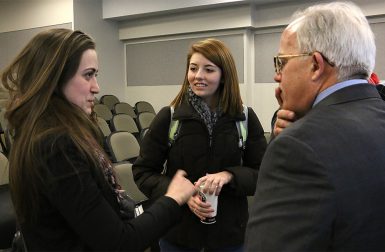Chicago Tribune editor discusses evolution from crisis mode to innovation

In 2008, the Tribune Media Company, one of the largest media companies in the nation, filed for bankruptcy after owner Sam Zell piled on massive debts during one of the worst economic recessions the country had seen since the Great Depression.
This crisis was accompanied by big news events in the city and state. The Illinois governor was under federal investigation for attempting to extort money for his appointment to fill the senate seat vacancy left by President-elect Obama. Obama, the nation’s first African American president, was headed to the White House. And the current model of print journalism was crumbling.
To say that Gerould Kern, BA’71, had a tough road ahead of him when he was named Chicago Tribune senior vice president and editor in July 2008 would be an understatement.
Kern shared the steps the Tribune took to respond to its own challenges as well as challenges that face papers everywhere during his talk, “Does Mission Matter? Journalism on the Digital Frontline,” Wednesday in Ernie Pyle Hall. Kern was both a guest of the school’s Speaker Series and was the school’s Roy W. Howard Lecturer.
“We were good at showing up and doing our jobs, but couldn’t clearly articulate why we were doing what we were doing,” said Kern of the Tribune staff at this time.
To address this, Kern led the Tribune in creating a six-part mission statement to guide its reporting. Kern said mission keeps in mind a quote from former subscriber President Abraham Lincoln that is inscribed on the walls of the newsroom: “Let the people know the facts, and the country will be safe.”
The objective to stand up for the community is especially important to a paper in a state where four of the last six governors are in prison, according to Kern. He said while typically skeptical reporters were quick to embrace the mission and embed it in the company’s culture, the paper was facing another problem not so simply solved.

Using graphs on a Powerpoint screen, Kern illustrated for the audience the large proportion of print subscribers who view Tribune content digitally and the much smaller percent of people who visit the online site and also subscribe to print. The paper had to evolve in order to keep up with this change in audience behavior, according to Kern.
“Over the past 15 years, we were producing websites as a byproduct of newspaper production,” he said. “We knew that this would not enable us to keep up with the pace of change, so we committed to reverse the process.”
Part of this process reversal was becoming fluent in digital audience metrics. While making sense of mass amounts of data is no easy task, Kern said journalists are the perfect group for the job.
“We put our reporters’ hats on, and we went to school on that data,” he said. “We are creating a companion discipline that can inform journalism itself.”
Kern also used charts to show which stories get the most traffic on the site and how the Tribune is using this information. For example, Kern said local and breaking news coverage are the most popular online stories, so they will soon be a part of the premium content that requires an online subscription.

The Tribune used the knowledge that national stories receive little traffic to establish the paper’s “Global City Project” initiative. This initiative challenges the paper to localize global and national issues by finding Chicago stories in far away places. For example, the paper wrote about Chicago architects who led the development of a new skyscraper in China.
Knowing what types of stories a digital audience is reading, however, is less important than knowing how this audience finds these stories, Kern said. Understanding the power of news sharing through social media and search engines is vital to understanding audiences.
“The audience has become the medium,” said Kern. “The newspaper or the website or the mobile app are not the medium at all. Our lifeblood is the relationship with the audience.”
While the dissemination of news through social sharing forces change upon the paper, Kern said behaviors of individual reporters must also change. He provided a list of tips for how an individual reporter can engage a digital audience. Tips included attracting a loyal crowd, building a personal brand and making sure content is always relevant.
During the Q&A session of the talk, audience members wanted to know if digital audiences’ intellect are declining and if attention spans are disappearing. Kern said analytics show that audiences will still read long-form journalism if the story is engaging enough. And, the ease with which newspapers can track which stories are ignored creates the illusion that a disengaged portion of the public is a new phenomena.

“I look at some of the data and I might say, ‘How do we know this hasn’t been the case all along with newspaper readers?’ My guess is that it has been,” said Kern. “We publish a lot of stories that people aren’t that interested in. We’ve just never had a way of seeing it before.”
In addition to his Wednesday evening talk, Kern spoke with students at the Indiana Daily Student and was interviewed on WFIU’s Profiles program while on campus. During his talk, he proudly displayed his first byline in the IDS and attributed his dedication to journalism to the lessons he learned as a student at IU.
“IU is the place where I took my first steps as a reporter,” he said. “This is the place where I learned about journalism’s mission of public service, transparency, accuracy, fairness and speaking truth to power.”

